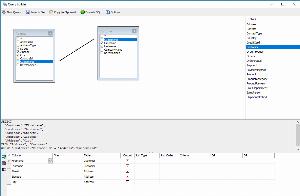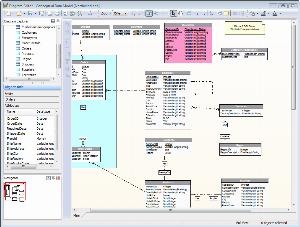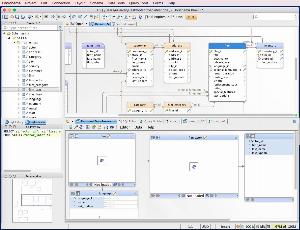Database design tools for Interbase
List of tools that allow for the design of a database.
Database design is a set of activities aimed at improving the development, implementation, and maintenance of an enterprise data management system. Its main goal is to reflect the outline of the database system into real models: physical and logical. Database designers determine what data is to be stored inside the database, and how objects are to be related to each other.
Dataedo
Dataedo is a metadata management tool with data description language (DDL) export. It reads your schema and lets you easily describe each data element (tables and columns) and other database objects (like triggers, stored procedures, etc.) visually as ER diagrams. Additionally, DDL export allows you to export your database to a set of statements like CREATE and ALTER.
| Desktop/Cloud: | Desktop |
|---|---|
| Generate DDL scripts: |
|
| Free edition: |
|
| ER Diagram: |
|
DTM Data Modeler
DTM Data Modeler is an easy-to-use tool allowing you to work both with logical and physical data models in the form of an entity-relationship diagram. The program can create database schema objects directly in the database and can create SQL scripts corresponding to the model taking into account the specified settings.
| Desktop/Cloud: | Desktop |
|---|---|
| Generate DDL scripts: |
|
| Free edition: |
|
| ER Diagram: |
|
Xcase
Xcase is a complete database design tool engineered to help you accomplish all your database-related tasks – from database design to modeling to daily modifications – with greater speed, higher quality, and better adherence to best practices.
| Desktop/Cloud: | Desktop |
|---|---|
| Generate DDL scripts: |
|
| Free edition: |
|
| ER Diagram: |
|
WinA&D
WinA&D is a comprehensive tool for system analysis, requirements management, structured analysis and design, object-oriented modeling with UML, and data modeling of information systems.
| Desktop/Cloud: | Desktop |
|---|---|
| Generate DDL scripts: |
|
| Free edition: |
|
| ER Diagram: |
|
ERD Concepts
ERD Concepts is a database designer and SQL query tool for all major databases. It helps to create a professional and visual attractive Entity Relationship Diagram with domains, tables, foreign keys, views, stored procedures, and more. Your base ERD design is alternatively used to generate DDL scripts to create the actual database.
| Desktop/Cloud: | Desktop |
|---|---|
| Generate DDL scripts: |
|
| Free edition: |
|
| ER Diagram: |
|
Gleek.io
Gleek.io diagram maker is freemium text-to-diagram tool for developers and software architects. It enables the visual design of database online, in the cloud and from any browser. Create informal, UML, or entity-relationship diagrams - using just your keyboard.
| Desktop/Cloud: | Cloud |
|---|---|
| Generate DDL scripts: |
|
| Free edition: |
|
| ER Diagram: |
|
Database Workbench
Database Workbench is a complete database development tool that facilitates to design and develop from a single conceptual data model to the different DBMS specific physical models. It lets you create and modify database objects in graphical editors with no need to remember specific SQL syntax.
| Desktop/Cloud: | Desktop |
|---|---|
| Generate DDL scripts: |
|
| Free edition: |
|
| ER Diagram: |
|
DeZign for Databases
DeZign for Databases uses ERD and data models to graphically design databases and automatically generates the most popular databases.
| Desktop/Cloud: | Desktop |
|---|---|
| Generate DDL scripts: |
|
| Free edition: |
|
| ER Diagram: |
|
RazorSQL
RazorSQL is an SQL query tool, database browser, SQL editor, and database administration tool. It provides visual tools to create, alter, describe, execute, and drop database objects such as tables, views, indexes, stored procedures, functions, triggers, and more.
| Desktop/Cloud: | Desktop |
|---|---|
| Generate DDL scripts: |
|
| Free edition: |
|
| ER Diagram: |
|
DbSchema
DbSchema is a intuitive designer for complex databases, visual interaction and documentation.
| Desktop/Cloud: | Desktop |
|---|---|
| Generate DDL scripts: |
|
| Free edition: |
|
| ER Diagram: |
|
ConceptDraw DIAGRAM
ConceptDraw DIAGRAM software gives the ability to describe a database using the Entity-Relationship model. The Entity-Relationship Diagram (ERD) solution of ConceptDraw contains all libraries, templates, and samples you may need for professional ERD drawing.
| Desktop/Cloud: | Desktop |
|---|---|
| Generate DDL scripts: |
|
| Free edition: |
|
| ER Diagram: |
|
The database design process can be very complicated. The more complex the system, the more sophisticated the tool is needed. Their functionality can vary greatly, however, core features include:
• creating and editing database objects,
• database architecture modeling,
• visualization of a database schema,
• tracking relationships between entities,
• grouping logically related objects into clusters,
• diagrams overview.
Database designer tools enable building graphical models and generating DDL scripts on their basis. The script describes data and relations between entities in the designed database. Furthermore, the tools enable reverse engineering (visualization of the model from the SQL script).
Key factors of creating a reliable and well-organized database are:
• a properly designed data structure,
• establishing what data should be stored in particular objects,
• how objects should be related to each other.
All of them can be improved by using the relevant Database design tool. Additionally, some of them allow the visual representation of data using ERD, makes it easier to visualize even more complex schemas.
Without proper software, development is based on raw code. This increases the risk of errors at the initial stage. The tools allow users to edit the visual layout using simple drag-and-drop functions. With a user-friendly interface, browsing the structure is possible even for non-IT people.
We have created a list of tools that support the process of creating database structure and its content. Our list includes free database design tools as well as advanced, more professional data management tools.
 SQL Server
SQL Server
 Oracle
Oracle
 MySQL
MySQL
 PostgreSQL
PostgreSQL
 Amazon Redshift
Amazon Redshift
 Azure SQL Database
Azure SQL Database
 DBT
DBT
 Google Big Query
Google Big Query
 IBM DB2
IBM DB2
 MariaDB
MariaDB
 SAP HANA
SAP HANA
 Snowflake
Snowflake
 SQLite
SQLite
 Teradata
Teradata
 Vertica
Vertica

















